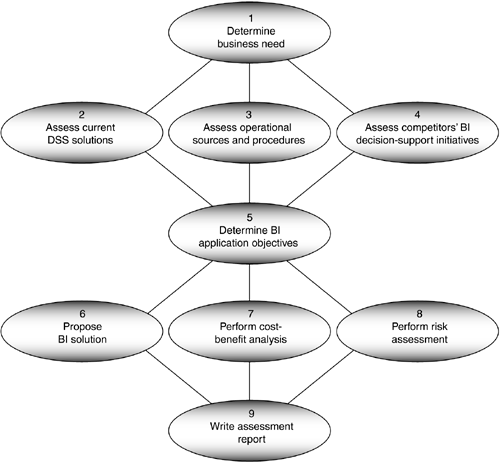The business case assessment activities do not need to be performed linearly. Figure 1.4 indicates which activities can be performed concurrently. The list below briefly describes the activities associated with Step 1, Business Case Assessment.
-
Determine the business need.
Justification of a BI project is difficult only if there is no obvious business reason for the BI application. There must be a clearly defined business information need that cannot be satisfied with traditional decision-support methods . The business need should be tied to a financial consequence for the organization, either as cost overruns or lost revenue. The financial consequence could be the result of a lost business opportunity (e.g., lack of access to vital information) or a business problem (e.g., reporting inconsistencies or reliance on dirty data). In either case, you must quantify the business need as a monetary expression (e.g., $5 million lost annually to the competition because of an inability to cross-sell to current customers).
-
Assess the current decision-support system solutions.
Examine the current decision-support system (DSS) solutions and determine their deficiencies. If the current solutions do not provide the information needed to mitigate the business problem, the reasons have to be understood . If the necessary information is not being delivered, it could be due to resource shortages and long backlogs in IT's workload. Other reasons could include difficulty accessing and merging source data because of different key structures, missing keys, or data redundancy and inconsistencies.
-
Assess the operational sources and procedures.
While assessing the current DSS solutions, give special attention to the operational source data and operational procedures. The business problem could exist because the business people cannot trust the information being delivered to them. Data quality problems may be the result of poor data entry practices, lack of edits, defective program code, or lack of training. A solution to the business problem may be to tighten those procedures.
-
Assess the competitors ' BI decision-support initiatives.
Staying ahead of the competition is extremely important in today's economy. In order to stay ahead, you must know what your competitors are doing. It would be helpful to know about the competitors' successes and failures with their BI decision-support initiatives and whether they have achieved higher sales or introduced innovative products.
-
Determine the BI application objectives.
Once you define the business problem and understand the deficiencies of the current environment, you can clearly state the BI application objectives. These objectives must be compared to the organization's strategic business goals to ensure that they are in synch.
-
Propose a BI solution.
Using the BI application objectives and the analysis results of the current environment, including the current DSS solutions, you can now propose a BI solution. The business problem may be too complicated to address all at once, in which case you will need to devise an iterative release approach. Unfulfilled requirements from previous BI projects must be evaluated and the decision must be made whether or not to include them in this release.
-
Perform a cost-benefit analysis.
Determine the projected BI application costs. In addition to new hardware, software, and tools, include ongoing maintenance fees and training costs. Remember to account for the costs of new employees if you need to hire more staff to administer the new tools or to perform new business activities, such as data mining. Determine the benefits of the BI application, both the tangible and intangible ones. Itemize how the BI application will solve the business problem and save the organization money or increase the organization's profit margin. Finally, calculate the ROI and indicate the time frame in which it will be realized.
-
Perform a risk assessment.
List all the possible risks for your project and create a risk assessment matrix. If you do not have sufficient information to produce a detailed risk assessment matrix at this time, use the six basic risk categories: technology, complexity, integration, organization, project team, and financial investment. Determine the severity of each risk: low, medium, or high. Also determine how likely it is that each risk will materialize and what impact it would have on the BI project.
-
Write the assessment report.
Describe the business need (whether it is a business problem or a business opportunity), and suggest one or more BI decision-support solutions. Include the results of the costs-benefit analysis and the risk assessment. Add a short summary to the report, and deliver it to the business sponsor as well as executive management.
